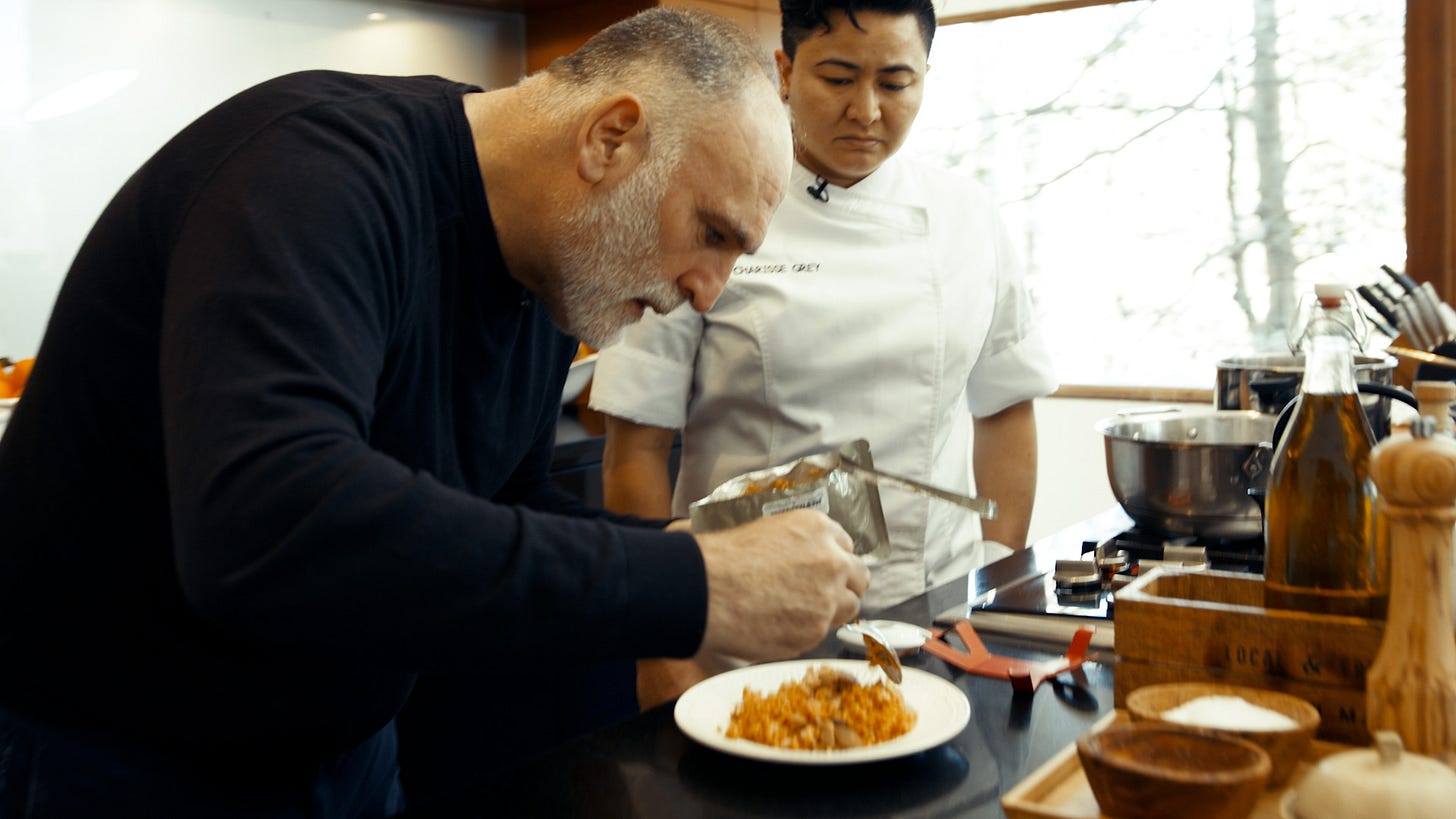Way back in 2020, a good friend and hero of mine, the astronaut Michael López-Alegría, approached me for help: Could I make good Spanish food he could take with him to space?
I jumped at the chance.
I didn’t want the easiest solution, but something that would be very delicious and meaningful to all Spaniards around the galaxy. It quickly came to us that we needed to make a rice, one of the most iconic Spanish dishes … and decided on a paella with chicken and mushrooms. It’s a classic of Spain and a dish that is meant to be shared and enjoyed together … an ideal meal for the International Space Station!
It was easier said than done, of course … and not because of the lack of gravity! NASA has very specific rules, for nutrition and especially for food safety. Everything must be pre-cooked in a sealed bag at a high temperature to eliminate any pathogens. Cooking in a sealed bag is pretty much the opposite of how us earthlings make paella…!
So I worked with Chef Charisse Grey, ThinkFoodGroup’s head of R&D, to lead the charge. Over months, she helped to make more than 100 different versions of our space paella. Below, she explains how she overcame the challenges—including a lot of exploding paella pouches!
The trick with making anything for space is that it’s all cooked in what’s called a Retort machine. We don’t have one—we are just a restaurant company, not a high-tech laboratory, after all!—and even if we did, each test batch is very expensive. So NASA recommended that we develop the recipe using a home pressure cooker.
When we first started researching, we were trying to quantify what happens when you cook a paella. How much water actually evaporated when the rice simmered in stock? We gave up on that pretty quickly and realized we just had to start trying different combinations of ingredients and adjust.
We had a lot of really bad versions. With too much water, the rice got mushy, like a pudding. Too little, the rice didn’t cook through. In this type of recipe development, just 10 grams of liquid, about two teaspoons, could mean the difference between success and failure.
We also had to figure out how concentrated the stock needed to be to flavor and season the rice. (Usually when you cook a paella, the stock cooks down and becomes more concentrated as it’s absorbed into the rice. Here it needs to be flavorful enough at the start to infuse the rice during a high temperature, fast cooking time.) In the end, we decided to reduce the stock by 50% before adding it to the pouch.
Other variables we had to play with: Do we add cooked chicken or raw chicken? (Cooked because we could not know how much liquid the meat would release.) Cooked mushrooms or raw ones? (Same answer.) Extra salt or no? (Yes, always.)
There was one problem with the pressure cooker—actually, two, but I’ll get to the second one later. The paella pouches kept exploding during cooking! Sometimes, after we shut the lid and started cooking, we’d hear a big pop. Sometimes it was just a burst of air escaping and we’d know: There goes another one. We probably lost three out of every four pouches we tested. Cleaning up was…a process.
When Charisse and I finally had a version we thought would work, we headed down to Clemson University in South Carolina to try them out in a real Retort. It did not go as planned. The paella came out like a solid rice cake. (So much for the pressure cooker being a good stand in!)
We rushed to the supermarket to buy all the different kinds of rice they had so we could do more tests. We tried frozen rice, white rice, Ben’s Original, and traditional Valencian rice. We had to do the same tests all over again, each rice with different amounts of stocks at different concentrations. We finally got two versions that seemed like they might work; one with Ben’s, one with Valencian rice. The food scientists wanted me to use the Ben’s. They’d used it before and were more confident about it. But I just didn’t think it tasted right … it didn’t taste Spanish. We ended up testing out both options for a final taste test. The decision was unanimous … everyone chose the Valencian rice, the true rice of Spain!
Could I tell the difference between a space paella and an earth paella? Yes, I think so. There’s a toastiness that’s missing from the pouch that you get from cooking over fire. And you could never get the socarrat, the much loved crusty rice that forms on the bottom of the paella pan, in something cooked in a bag. But if I’m being honest, the space paella is really good.
To me, this is a dream come true, to see astronauts from different countries share paella in space. Thank you NASA (and of course Chef Charisse!!)









Very interesting and fun article. I respect your work, whether on Earth or in space.
What a great story and a wonderful thing to do! Food is to me, the biggest reminder of home, family and loving comfort. I can only imagine how much it meant to him in space, not to mention how great it must have tasted. Genius!